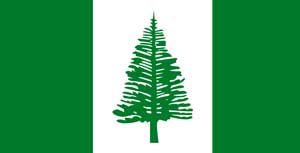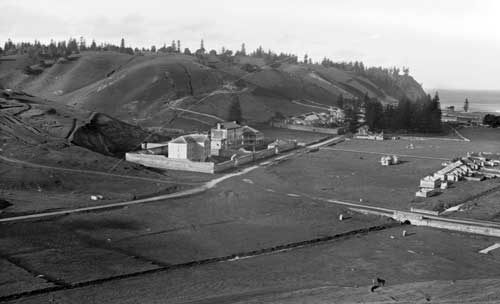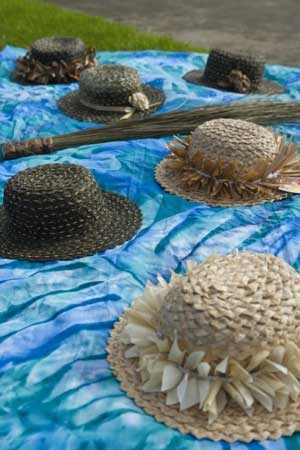Map
Flag

Quick facts
Official Name: Norfolk Island
Indigenous Peoples: A mixture of Pitcairn descendants, Australians and New Zealanders
Official Languages: Norfuk (also spelled Norfolk or Norf’k), English
Political Status: External Territory of the Commonwealth of Australia
Capital: Kingston
Population: 2,210 (2014 est.)
Greeting: Wataweih
History and geography

Originally, Norfolk was settled (perhaps only seasonally) by East Polynesians some 1,000 years ago. The fact that no human remains from this period have ever come to light may indicate that the people came and went without permanently settling on Norfolk.
Norfolk Island is in the South Pacific Ocean, east of the Australian mainland. Norfolk Island, along with two neighboring islands, makes up one of Australia’s external territories. The territory encompasses an area of 34.6 sq km (13.4 sq mi), with no large interior bodies of water, and 32 km (20 mi) of coastline. The terrain is volcanic with rolling plains. Most of the terrain is suitable for farming and other agricultural uses. The island’s climate is subtropical and mild, with little seasonal temperature variation. Typhoons occasionally strike the island, especially between May and July.
The evergreen Norfolk Island pine is a symbol of the island and is pictured on its flag. The pine, native to the island, is a key export and a popular ornamental tree on mainland Australia – where two related species grow – and also worldwide.
The first European known to have sighted and landed on the island was Captain James Cook in 1774, on his second voyage to the South Pacific on the vessel HMS Resolution. He named it after Mary Howard, Duchess of Norfolk. Norfolk Island was colonized by Great Britain as part of its settlement of Australia in 1788, mostly as an effort to keep other European powers, particularly France, from colonizing the area. The first settlers were six women convicts “whose characters stood fairest,” nine male convicts, and eight free men. It was hoped they would create a community that could produce masts and sails with the available pine trees and flax, as well as produce food for the barren settlement Australia. The island served as a convict penal settlement until May 1855, except for an 11-year hiatus between 1814 and 1825, when it was abandoned because of bad working conditions and starvation. The prisoners were sent to Van Diemen’s Land (Tasmania).
The most important catalyst of today’s Norfolk Island culture is the infamous mutiny on the British ship HMS Bounty. The mutineers and their Polynesian companions found Pitcairn Island, and there a unique culture was born. Years later, in 1856, the entire Pitcairn community of 194 people arrived upon Kingston pier on Norfolk Island to greet their new home – a home where their descendants still live today.
The Pitkerns occupied many of the buildings remaining from the penal settlements, and gradually established traditional farming and whaling industries on the island. Although some families decided to return to Pitcairn in 1858 and 1863, Norfolk Island’s population continued to grow. Additional settlers arrived, often with whaling fleets. Subsistence farming was the main economic resource, with whaling taking over in the 1840s. In 1901, the island became a part of the Commonwealth of Australia. The Melanesian Mission worked in the island for 50 years, and set up the Church of St. Barnabas, which remained after the mission closed down in 1920. During World War II, an airstrip was built, allowing the start of a tourism industry.
The language widely spoken, Norfuk, is a blend of 18th-century English and ancient Tahitian, originally introduced by Pitkern-speaking settlers from the Pitcairn Islands. Its use has diminished, and it is recognized by UNESCO as an endangered language. However, there are efforts to keep the language alive through community programming.
Today, Norfolk Island is a self-governing territory administered from Canberra. In 2008, the Council of Elders, the original from which the island’s community political system evolved, was re-established with the goal of protecting, preserving and promoting the identity, values welfare and well-being of the community and its unique cultural knowledge and expression. Tourism is the primary economic activity. As Norfolk Island prohibits the importation of fresh fruit and vegetables, produce is grown locally. About 25% of the island is used for farming.
In 2015, a company in Norfolk Island was granted a license to export medicinal cannabis. The medicinal cannabis industry has been viewed by some as a means of reinvigorating the economy of Norfolk Island. However, it remains to be seen how this may be affected by recent reforms to the legislative decision-making processes of the island.
Arts and culture

Most Norfolk Islanders are Australian, followed by New Zealanders, and then a small percentage of Fijians, Filipinos and English. Most residents are Christian. Some Tahitian traditions were passed on, including hula and some dance forms. Traditional handicraft production also persists, such as weaving. Artists abound on Norfolk Island – painters, potters, poets, actors, musicians, sculptors, quilters, and artisans of every nature – and Norfolk artists continue to participate in the Festival of Pacific Arts with other island nations and states.
